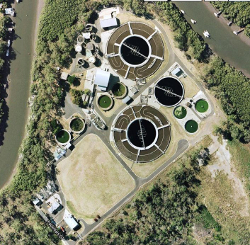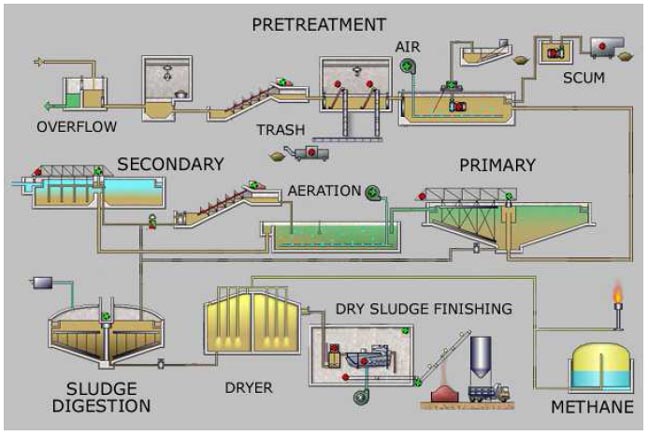|
|
Treatment systems for intensive land usesWastewater treatment occurs at special facilities called wastewater treatment plants. Wastewater treatment is the same as what occurs naturally in aquatic systems such as wetlands, lakes and rivers. However the purpose of wastewater treatment plants is to speed up Nature’s natural cleansing process. Over time the practice of wastewater collection and treatment has been developed and improved, using a variety of biological, physical, chemical and mechanical processes to protect public health and water quality. Treatment wetlands are sometimes added as a ’polishing’ stage to further improve the quality of the treated wastewater. Quick facts
Wastewater sourcesWastewater is the flow of used water discharged from homes, businesses, industries, commercial activities and institutions which is then directed to wastewater treatment plants by carefully designed, engineered and operated networks of pipes. This wastewater can be then further categorised and defined according to its sources of origin. The sewage collection system collects wastewater from domestic and non-domestic sources and consists of thousands of kilometres of pipelines that convey the wastewater to the wastewater treatment plant. The term domestic or municipal wastewater refers to from residential sources generated by such activities as food preparation, laundry, cleaning and personal hygiene. Industrial/commercial wastewater is flow generated and discharged from manufacturing and commercial activities such as printing, food and beverage processing for example, and this industrial wastewater is typically treated partially before being discharged to sewage collection systems and ultimately treated further at wastewater treatment plants. The amount of flow handled by a wastewater treatment plant typically varies with the time of day and with the season of the year. Intensive animal husbandry, such as piggeries, feedlots, poultry farms and dairies, also produce effluent that needs to be treated and/or reused on farms.
Wastewater treatment objectivesThe overall objectives of wastewater treatment are two fold:
Discharge from a sewage treatment plant or industrial wastewater is often classed as a point source discharge. The Queensland Environmental Protection Act 1994 regulates these activities and ensures that treated effluent release to receiving waters does not cause ‘environmental harm’. Wastewater treatment processesWastewater treatment facilities incorporate numerous processes, which in combination, achieve certain desired water quality objectives. These processes involve the separation, reduction, removal and disposal of certain contaminants present in wastewater. The treatment of municipal wastewater is accomplished typically by four basic methods or techniques; physical, mechanical, biological and chemical:
Wetlands can be used as a ‘polishing’ stage after conventional treatment processes. They can effectively remove additional nutrients and suspended solids[1]. Wetlands can also be used to treat sewage and other wastewaters with high levels of contaminants. Capital and operating costs of such systems are lower than mechanical treatment systems, as is energy use, but the treatment effectiveness may not be as high, depending on the design and hydraulic retention time of the system[2][3][4]. Treatment systems may also be used off site as water quality offsets for intensive land uses.
Additional InformationIntroduction to Wastewater Treatment Process: Why We Treat Wastewater (1 of 4) Introduction to Wastewater Treatment Process: Headworks Treatment (2 of 4) Introduction to Wastewater Treatment Process: Secondary Treatment (3 of 4) Introduction to Wastewater Treatment Process: Biosolids Treatment (4 of 4) A Drop of Knowledge – The Non-operators Guide to Wastewater Systems U.S. Environmental Protection Agency
Piggery manure and effluent management References
Last updated: 27 June 2022 This page should be cited as: Department of Environment, Science and Innovation, Queensland (2022) Treatment systems for intensive land uses, WetlandInfo website, accessed 18 March 2024. Available at: https://wetlandinfo.des.qld.gov.au/wetlands/management/treatment-systems/for-industrial/ |

 — Department of Environment, Science and Innovation
— Department of Environment, Science and Innovation




